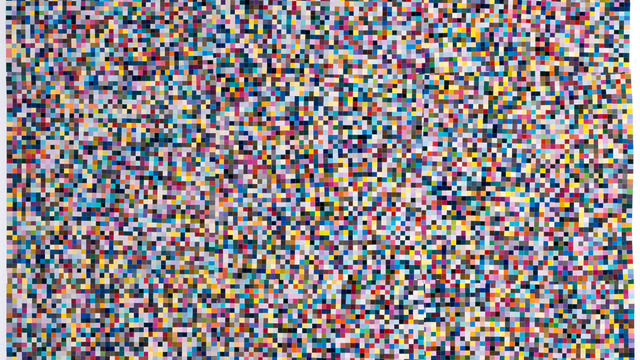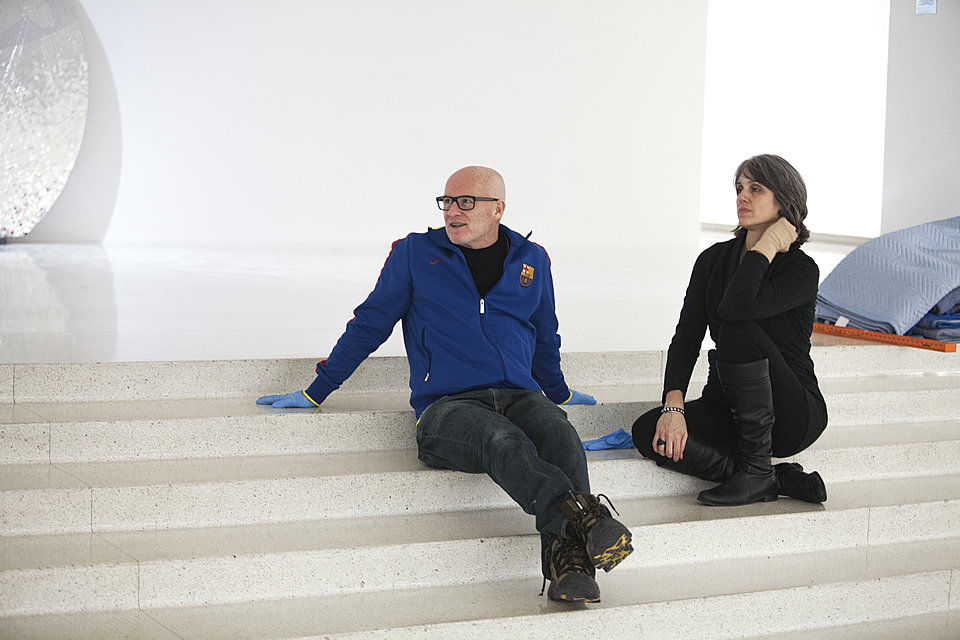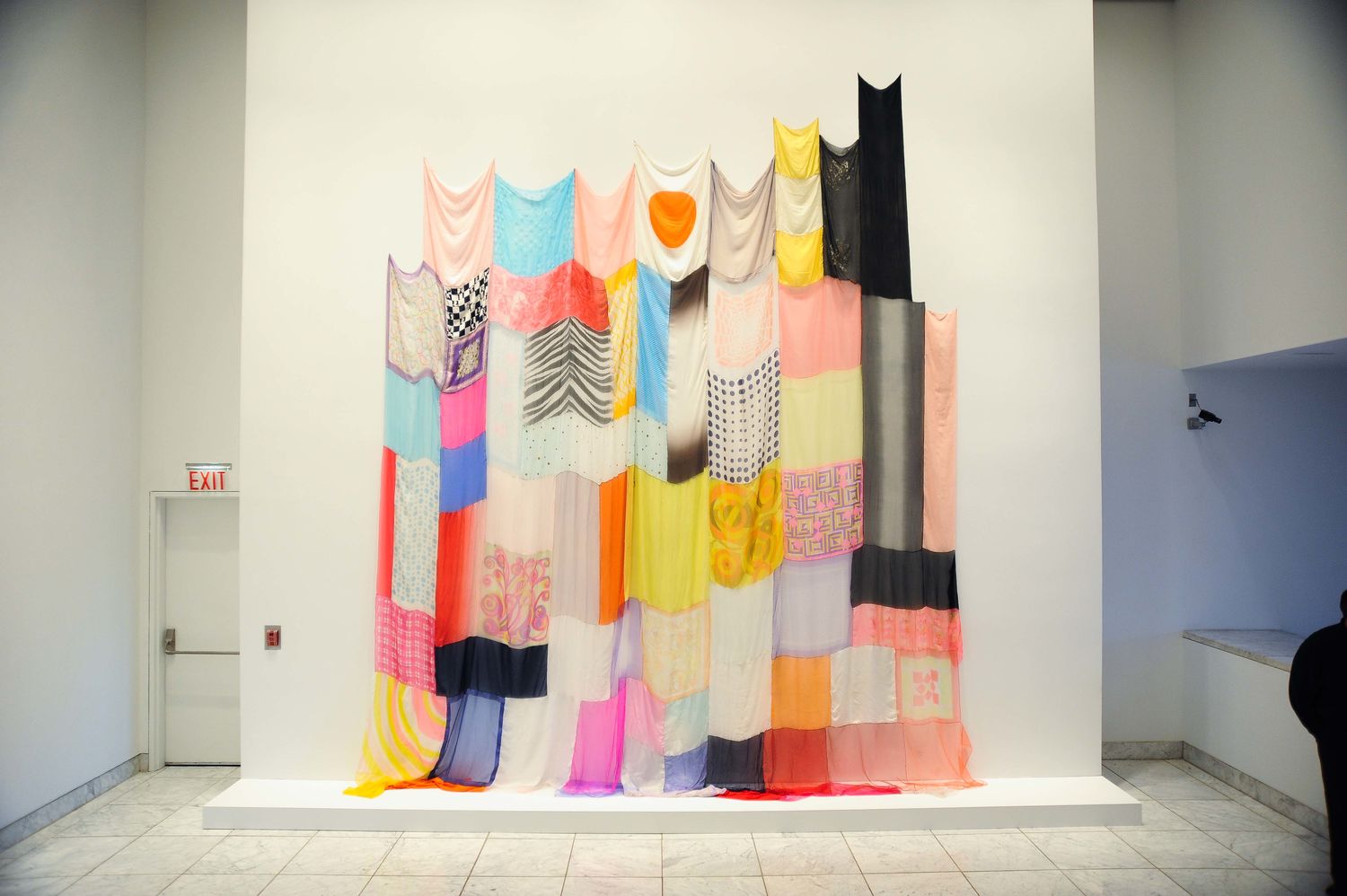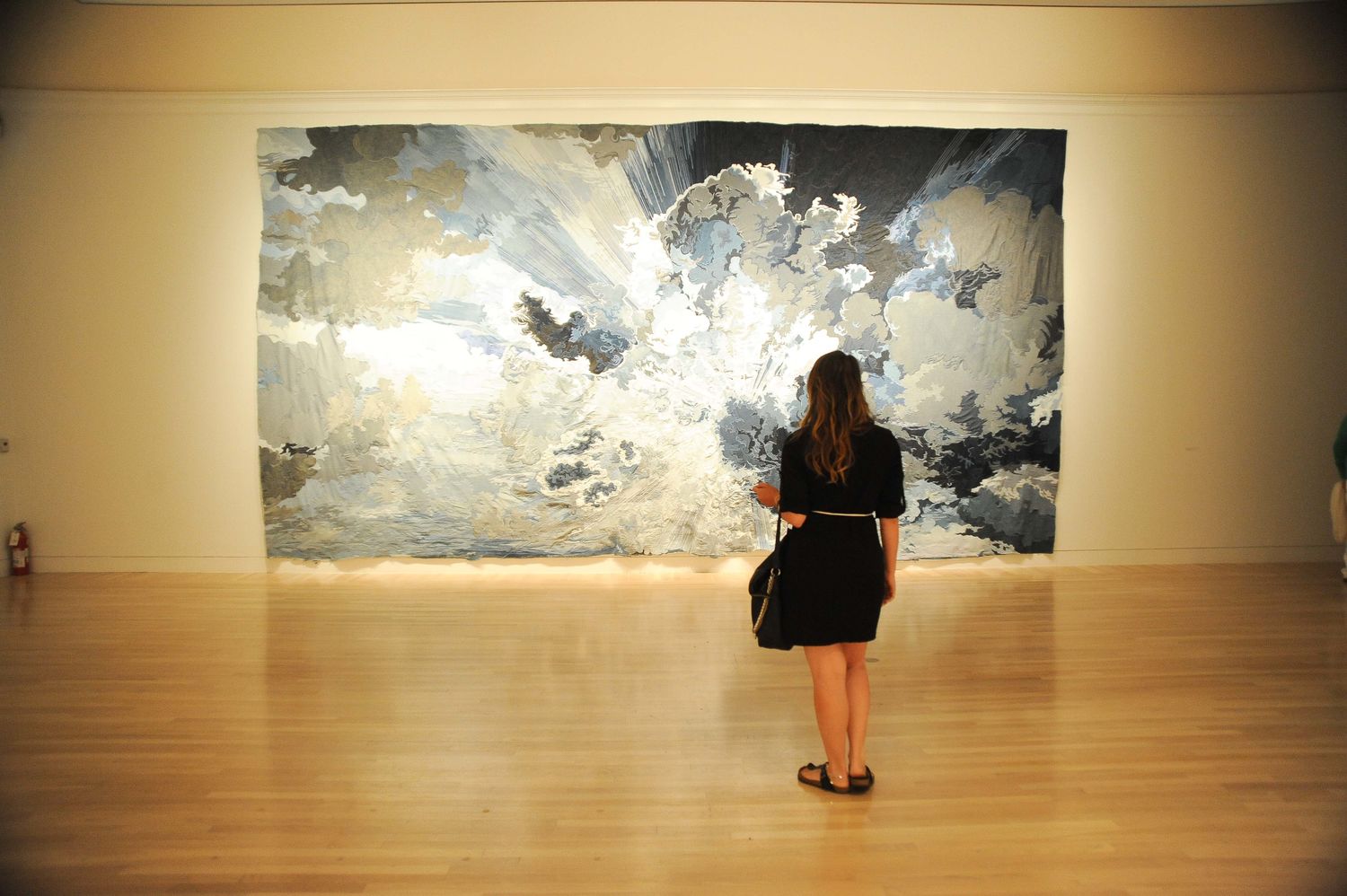
Choreographing Experiences in Space: Olga Viso Interviews Jim Hodges
An extended version of this post originally appeared on the Walker Art Center's blog in February 2014. Jim Hodges: Give More Than You Take is on view at the Hammer through January 18, 2015.
“I love sculpture,” Jim Hodges says. “Fundamentally, though, I am a ‘drawer.’ But I love spatial relationships and dimensionality. I’m interested in theatrical moments and choreographing experiences in space. I think as a drawer and make as a sculptor.” Over the course of three years, the artist and Walker Art Center executive director Olga Viso delved into Hodges’ life, artistic practice, and influences, touching on topics prevalent in his work, from love and politics to language, spirituality, and mortality. Excerpted from the exhibition catalogue Jim Hodges: Give More Than You Take, here’s a sampling from their discussions.

On First Encounters
Olga Viso
You’ve heard me tell the story before, of the first time I saw your work Here’s where we will stay (1995) and how I was transported by that wall sculpture made of silk scarves to an intimate moment from my childhood. One of the things that struck me most about that experience was having such a private moment within the public context of a gallery.
Jim Hodges
Making that work had childhood references for me too. When I was a kid, my brothers and I would put two card tables together and drape them with sheets to construct forts in the living room. These caves of soft cotton made perfect hiding places and spaces of fantasy in which to conjure imagined scenes, where we could become pirates or cowboys and Indians. I find that memories are transmitted through materials, especially when one is engaged in slow, constant contact with them.
When I started sewing the silk scarves together, I became lost in their softness and their color, choosing shades that I might find in the changing skies. At this time, I had also been giving the paintings of Sigmar Polke a lot of consideration. Elaine Dannheisser, who had given me a basement studio space in which to work at her art foundation [in New York], had begun to more aggressively collect Polke, so I was brought into close proximity with a few of his paintings. Some of them were made of disparate fabrics that had been sewn together. I would look at the paintings and think, “Why the paint? Isn’t the fabric enough?” And at the time, for me, the fabric was enough.
I had been sewing for some time when I started making Here’s where we will stay. It was something I learned from watching my great-grandmother and my mom sew when I was a kid. My first boyfriend, Robert Valenciano, whom I met in 1986, was a designer/tailor and an incredibly inspiring, adventurous guy. His sewing also influenced me and reminded me of the potential that lay in that process. Making Here’s where we will stay was a very slow process because I did not want to use a sewing machine. I wanted to sew it by hand to extend the process and slow the experience for myself. So I sat for a long time, sewing, taking the scarves out to a bench along the Hudson River in Tribeca close to my Dannheisser Foundation studio.
It’s nice to hear you recount your visceral reaction to seeing the piece for the first time in the gallery, and how it was being animated by the wind that blew through the big doors. This animation of the materials heightened your experience and triggered your memories, which transported you, just as the making of it had transported me.
I was after a queer expression when I set out to make the piece—choosing the scarves, sewing them together, and even all the decisions that went into how the work would be constructed, installed, and titled. In all those choices, and then in the specific installation in which I utilized and exploited the natural “materials” of the space itself, it all added up to that moment when you arrived. You describe a very personal experience that erupted from you, initiated by what was present there. That moment contained the actual “art,” and it was located in you. You unfolded internally the private in the public … that’s the function and the mechanism that we think of as art, right?
Viso
Indeed. Did the scarves belong to family members, or did you collect them? They are so specific to the era of each of our childhoods.
Hodges
I was on a hunt for scarves, although I did have some that came from my mom and grandmothers. I had the experience as a kid, like you, of going through my grandmother’s drawers and finding them. My mom wore scarves, and the smell of Shalimar perfume would always linger on them. I’m lost to the romance and sensuality that fuse onto these materials. Most of the scarves in the piece were found at thrift stores or flea markets; I collected hundreds of them and still have a few of my favorites. I used to wear them and give them away to friends.
Viso
But to make a sculpture out of them is something else.
Hodges
I was making what I thought of as a “painting.” I had been in a slow process of what I would call now, in retrospect, “coming out,” while simultaneously finding my voice through materials and process. This simultaneous process of developing language and identity marked this period in my life. Moving from making pieces in which I had been using black and gray felt to colored fabrics was part of that process. Color itself was something that was very slow to return to my work after putting the paints away. The fabric and then the scarves brought me back to color.
Viso
You moved away from painting fairly early in your career. For your generation, painting was a weighty subject, especially in art school where your teachers must have been steeped in the Abstract Expressionist tradition.
Hodges
I received my MFA degree in painting from Pratt Institute [in Brooklyn], and my favorite teacher there, Phoebe Helman, was an old-school New York abstract painter—a “no bullshit” kind of a person. She was tough, and I got the most from her when I was at Pratt. Painting was all I knew then, really. Although I was slowly beginning to think about making objects, I was mostly thrashing about while in art school, lost in the hugeness of painting. The medium ended up being too complicated for me. There were too many variables, too much history, and too many choices. It was overwhelming. I also felt I was underserving the medium. I could mimic stylistically a number of art historical references in painting, but I was not able to find a way to my “self” through the material. At the height of my struggle, I got important advice from my friend and teacher from undergrad studies [at Gonzaga University in Spokane] Scott Patnode, who told me: “Do what makes you happy.”
Drawing was always a favorite thing to do, so I put the paints away and picked up the most basic materials I knew: charcoal and paper. That simple choice was a definitive moment for me. Scott’s instruction to look for my pleasure was an important fundamental direction. This turn initiated what I now call my “practice” and started me on my way.

On Liberation
Viso
Could you speak more about how pleasure factors into your practice?
Hodges
In this moment I just described, I began to pay attention to pleasure as an indicator and instructive function of my body; I tried to be sensitive to my gut as a way to zero in on things, on materials, and how they could be brought together and manipulated. It was the very beginning of identifying a personal symbolic iconography and inventing methods for making. It was a rich period of questioning and growth in which I sought to understand my personal relationship to the history of art and its authority, which I had, up until then, simply taken for granted, with a kind of submissive acceptance coming out of my education.
In the basement of the Dannheisser Foundation, I began to take it all apart. I literally utilized a kind of destructive and reductive method to get into things I was interested in or that caught my eye. I came to realize that I’m a destroyer as much as I’m a maker. I find the disassembly (or the taking apart or breaking) of something as important in my practice as constructing things. It’s been almost my default mode, to destroy. I have a soft, destructive nature.
Viso
What was the next liberation?
Hodges
I think I’ve always strived for freedom in my life, at least for as long as I can remember. Perhaps it is a reaction to feeling repressed and isolated as a kid. I was a very introverted child, living my life primarily inside a fantasy that I maintained, or used, to make being here bearable. It sounds far more dramatic than it probably was, but I was a seriously interior guy who projected a friendly, easy façade. Liberation came to me slowly, and perhaps the liberation from painting to drawing led to further liberations. Breaking free of the notion of some outside authority was the major breakthrough and the start of a mature practice, which has consisted of letting myself do whatever, not saying “no” to myself. “YES!” was what art said to me.
Viso
Much of what you say resonates with me as someone who also grew up Catholic, indoctrinated in ritual, in tradition, in particular values and beliefs defined by limits.
Hodges
I think that so much of my liberation has been slow because I was the good Catholic boy, an altar boy who thought he wanted to be a priest when he was in grade school. I was twenty-seven years old when I said, “I am no longer identifying or presenting myself as a straight man.”
I have been through a process of shedding skins, breaking through boundaries—imposed, self-imposed, learned, whatever—and the funny thing is, there’s always another wall that I go crashing into, another layer of crap to shed, another blossom that reveals more complexity and challenges. Thankfully this process doesn’t stop.

On Language and Translation
Viso
Would you describe yourself as a sculptor?
Hodges
I love sculpture. I think of things sculpturally in regard to spaces and contexts. Fundamentally, though, I am a “drawer.” But I love spatial relationships and dimensionality. I’m interested in theatrical moments and choreographing experiences in space. I think as a drawer and make as a sculptor. Or maybe I have that reversed?
Viso
In scanning the critical writing on your work, I’m struck by the dearth of significant art historical texts. Poets and literary authors seem to come closer to grasping the essence of your practice. Do you think of it as a poetic or literary practice?
Hodges
In regard to what has been written about my work, or even how to approach writing about art, I might ask: What is to be accomplished through writing? Is what’s written meant to act as a stand-in for experience? Is the burden of the writer to feel that he or she must in some way illustrate or re-create a particular reality, re-create or invent a verbal equivalent? I’m not a writer, and I don’t envy the person who has the challenge of writing about art. Writing, like any creative form, is a challenge, and it fails or succeeds at the hand of the artist. Writing about art is like singing about a book or dancing a poem; sometimes translations overlap and forms meld. Written language is the most specific and detailed, and therefore I think it poses the greatest amount of challenges when it comes to talking about visual art—especially with work such as mine, which innately resists being pinned down, or won’t stand still, or lacks even the body to insert the pin through. That’s a problem. If one has to invent the body to insert the pin, so that it can be held down, then that’s where things start falling apart. It’s the problem with interpretation and translation from one form to another, when in fact the form of the original is set and specific. Translating it changes it and can leave it behind.
Viso
Our discussion around the limits of language and the transmission of equivalent content in alternate forms makes me think about a piece you made in the years following the tragedy of September 11, 2001. It began with words—a simple written phrase, “don’t be afraid.” First a drawing, then a bumper sticker, the work ultimately evolved into a major public project that brought more than one hundred international voices together. It was presented as a wall mural at the Worcester Art Museum [in Massachusetts] in 2004 and wrapped the façade of the HirshhornMuseum and Sculpture Garden on the National Mall in Washington, DC, in 2005–2006. In many ways, this project was born of an amazing act of translation and communication. Your approach, which was a simple invitation to participate, seems to have unmoored that delimiting “pin” you just described.
Hodges
I made a small drawing titled “don’t be afraid,” as a kind of personal reminder. It was the year 2000, and I had recently moved with my partner at the time [Craig Ducote] from Brooklyn to the San Francisco Bay area to take part in an artist residency program at Capp Street Project. The move disrupted my rhythm and set me off into a whirl of insecurity, in which I found myself displaced and struggling to stay connected and committed to my practice. Upon their rendering, the words “don’t be afraid” became a kind of mantra for me that I incorporated into my routine. I’m a creature of habit and ritual, so this action was not anything new for me. I’m also a creature of emotional sensitivity and insecurity, and mantras are something that I have utilized for a long time but never directly in a piece of art. Once the expression was made physical, I found other opportunities in which it could become manifest.
In 2004 I was invited by Susan Stoops, a curator at the Worcester Art Museum, to respond to a large wall in the museum rotunda. It was during the years of the George W. Bush administration, and a hyperpropagandized period in America in which the government was instilling a huge amount of fear in its citizens. It was a dangerous and traumatic moment, when the official message of the US government was that to be safe one had to be on alert, implying that somehow we were not “safe” at all. I felt that the destruction of the World Trade Center had been utilized in the most monstrous and aggressive way to make us all victims of government, in which our own political leaders were behaving like terrorists. When pondering the huge blank wall of the museum rotunda at this moment, I asked myself, “What would I like to say to everyone walking into the museum, especially every small child?” The phrase “don’t be afraid” seemed the most direct and efficient way of expressing and offering some comfort and support. I then asked myself, “How can I reach every individual? How could I ‘speak in tongues’”?
I realized I needed a “world translator,” so it occurred to me that my neighbors in New York City, the United Nations, might be willing to help. I wrote a letter of invitation to all the UN delegates at the time and asked each person to write, in his or her own hand, the words “don’t be afraid.” The invitation revealed my intent, which was for each individual piece of handwriting to unfold in a field of unique “voices.” Each hand would offer its own individual gesture, touch, and intonation of feeling and, together, they would create a global chorus of voices conveying a collective message of love. I received numerous responses to my invitation, and over time more than one hundred translations in over seventy languages arrived. Most countries were very enthusiastic about participating, save for one; the only country to formally refuse to participate was the United States. I twice appealed to the US delegate and both times I was refused. I was shocked at first by this reaction, but then understood. What other kind of response would one receive from a government in which the official message is to be afraid? Thankfully, Great Britain and Australia replied to the invitation and therefore English is “spoken” in the piece.
Viso
The subsequent realization of the project in Washington—within view of the US Capitol and across the street from the Federal Aviation Administration—was especially potent. As deputy director of the Hirshhorn at the time, I recall getting a call from an FAA administrator, who was immensely grateful to have your project visible from the FAA conference room. The silent chorus of international voices became a mantra of sorts for him and numerous staff, contractors, and government officials who regularly utilized the space during the many months the mural was installed on the museum’s façade. Who knows what plans and policies were shaped (or altered) by the presence and generosity of your global mantra!
Hodges
As often happens when making work, one rarely knows where it will end up or who the audience will ultimately be—or if there will even be an audience for that matter. The fact that you brought the work to the National Mall provided the opportunity for the work to “respond” in a direct way to the very government that provoked its inception. It is a high point of my working life to have had this piece installed in Washington during the time when the Bush administration was causing so much horror and instilling fear in the American populace. That all of our combined efforts—yours, mine, the UN collaborators—ultimately resulted in this work’s visible placement and presence on the Mall and that it may have led to the potential positive effects you suggest … what could be better?
The remainder of this interview will be published in future blog posts. Stay tuned.




